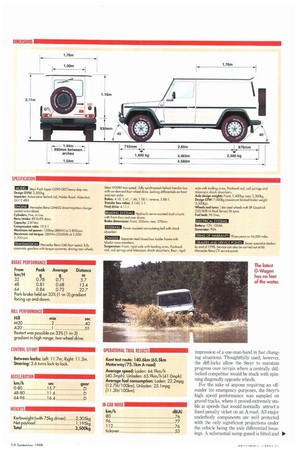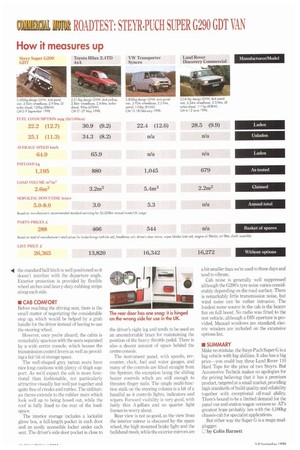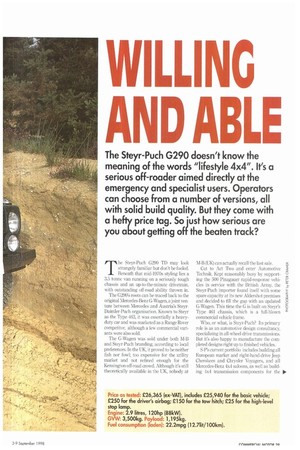The Mercedes marketing connection still exists, with this latest G-Wagen
Page 32

Page 33

Page 34

Page 31

If you've noticed an error in this article please click here to report it so we can fix it.
being sold under whichever badge is deemed best for individual markets—apart from France where naturally it's fitted with a Peugeot engine and badge!
The Steyr G range is based around three bodystyles. Flagship of the range is the 4.1 tonne G VW, 3.4m wheelbase chassis-cab in single or double cab versions, providing a basis for off-road emergency vehicles or crew transport. Running on a shorter 2.85m wheelbase are both the three-door panel van and the five-door station wagon.
Both models are available as standard 2.9 tonne (standard) and 33 tonne (heavy duty) versions, the difference being provided by uprated axles and a shorter axle ratio. A 2.4m wheelbase three-door station wagon is also available, but Automotive Technik doesn't see passenger variants as being a major plank in its marketing strategy The only powertrain offered in the G290GDT is the five-pot turbo-diesel engine and four-speed automatic gearbox straight out of the Mercedes Sprinter 3121). The sole significant change is the use of an air-to-water charge-cooler, instead of the Sprinter's air-toair item. The transfer box and axles are Steyr's own products. The helical gear driven transfer box is mounted high up between the chassis rails away from potential damage and includes provision for a power take-off.
• PRODUCTIVITY When you consider that the Steyr's 4x4 automatic transmission sits underneath a body with the aerodynamics of a brick outhouse, you realise that its fuel consumption of 22.2mpg (12.71it/ 100km) at 3.5 tonnes is not too bad; sonic smoother shaped on-road vans would struggle to do any better.
Access to the rear is through a single door, hinged on the wrong side for the UK. Double barn-type doors, opening through 180°, are available, and would be essential for forklift loading. The spare wheel is fitted on the out
side of the door but can be mounted elsewhere. The loadspace is 1,760mm long with a width between the wheel arches of 990mm, widening to 1,440mm for the remaining one third of the length. Loading our test weights presented an unusual difficulty; spreading 1,195kg over just 2m2 of floor space meant stacking them rather high. Fortunately a solid steel lower bulkhead with a mesh top section is fitted. No tie-down points were fitted to our test vehicle, although we are assured they will be added to future vehicles. Floor level of the unladen van is a hefty 830mm above the ground. A 50mm ball towing hitch is fitted, and a front towing eye is cunningly hidden behind a folding numberplate plinth.
Top left: Sprinter instruments are well integrated. Above: The functional cabin is spacious with well shaped seats. Above left: The centre console houses transmission conirols. Right Cubby boxes utilise underseat space.
• ON THE ROAD The outstanding impression when driving the Steyr G for the first time is its size. From afar, its proportions are such that you could be looking at something just a bit bigger than an Escort van, but get on the road and you find yourself looking down on Transit drivers. To put it into perspective, its wheelbase is two inches longer than a Land Rover Defender 110, But despite its physical bulk, it drives like a smaller car, with positioning in traffic helped by the giant indicator units perched atop the front wings.
In all normal road conditions the handling is excellent, with precise steering and none of the roll and bump steer that can affect other vehicles of this type. During on-road use, the lack of steering self-centring is noticeable and the steering gets slightly more vague when running at maximum weight. In the extreme circumstances encountered on our test track's handling course, the first sign of trouble was given by the sidewalls of the high profile tyres giving up, but in plenty of time to avoid an impending disaster. Ride is firm but never uncomfortable. The performance of the front disc/rear drum brakes, without the optional ABS, is
excellent in the dry, but was limited on wet asphalt due to the characteristics of the off-road tyres. The tyres' traction can also be broken by unleashing all the torque from standstill—for a rapid exit from a T-junction into traffic, it was worthwhile engaging four-wheel drive, especially in damp conditions.
The Sprinter automatic transmission fitted is a relatively unsophisticated unit by current car standards with no clever dual mode systems or the like. It's just a simple four-speeder with the usual kick-down facility, which needs a hefty push to activate. Although the fully laden van does not feel very quick under acceleration, the actual figures tell a different story, being not far off the 3.5-tonne classleading Sprinter 312D. The only time when performance is a problem is when diving into traffic from a standstill—the torque converter and turbocharger combine to give a noticeable amount of lag which must be anticipated. The transmission exhibits quite a bit of creep even in high range, ticking over at 750rpm.
Off-road the Steyr really comes into its own. There are some who might question the wisdom of automatic transmission on a 4x4, but having experienced it in action we were impressed by the degree of control possible in tricky situations. Particularly useful is the fact that even if you misjudge the gear needed for a hill climb, you can still downshift without a potentially disastrous declutch and loss of traction. Controllability is further helped by the gear selector quadrant's design, which has the normal PRND321 layout, but with the 1-2 change working from left to right rather than front to rear, which could be inadvertently selected on bumpy terrain.
To get the most from the Steyr's considerable off-road capabilities, use of the separate front and rear diff-locks needs to be continually monitored, which can result in a fair impression of a one-man-hand in fast changing situations. Thoughtfully used, however, the diff-locks allow the Steyr to maintain progress over terrain where a centrally dufflocked competitor would be stuck with spinning diagonally opposite wheels.
For the sake of anyone requiring an offroader for emergency purposes, the Steyr's high speed performance was sampled on gravel tracks, where it proved extremely stable at speeds that would normally attract a fixed penalty ticket on an A-road. All major underhody components are well protected with the only significant projections under the vehicle being the axle differential housings. A substantial sump guard is fitted and ■ 41 the standard ball hitch is well positioned so it doesn't interfere with the departure angle. Exterior protection is provided by flexible wheel arches and heavy-duty rubbing strips along each side.
• CAB COMFORT Before reaching the driving seat, there is the small matter of negotiating the considerable step up, which would be helped by a grab handle for the driver instead of having to use the steering wheel.
However, once you're aboard, the cabin is remarkably spacious with the seats separated by a wide centre console, which houses the transmission control levers as well as providing a fair bit of storage space.
The well-shaped grey tartan seats have nice long cushions with plenty of thigh support. As we'd expect the cab is more functional than fashionable, not particularly attractive visually but well put together and quite free of creaks and rattles. The utilitarian theme extends to the rubber mats which look well up to being hosed out, while the roof is fully lined to the rear of the loadspace.
The interior storage includes a lockable glove box, a full-length pocket in each door and an easily accessible locker under each seat. The driver's side door pocket is close to the driver's right leg and tends to be used as an uncomfortable brace for maintaining the position of the heavy throttle pedal. There is also a decent amount of space behind the centre console.
The instrument panel, with speedo, revcounter, clock, fuel and water gauges, and many of the controls are lifted straight from the Sprinter, the exception being the sliding heater controls which are stiff enough to threaten finger nails. The single multi-function stalk on the steering column is a bit of a handful as it controls lights, indictors and wipers. Forward visibility is very good, with fairly thin A-pillars and no quarter light frames to worry about.
Rear view is not so good, as the view from the interior mirror is obscured by the spare wheel, the high mounted brake light and the bulkhead mesh, while the exterior mirrors are a bit smaller than we're used to these days and tend to vibrate.
Cab noise is generally well suppressed although the G290's tyre noise varies considerably depending on the road surface. There is remarkably little transmission noise, but wind noise can be rather intrusive. The loudest noise source in the cab is the heater fan on full boost. No radio was fitted to the test vehicle, although a DIN aperture is provided. Manual windows are standard; electric winders are included on the extensive options list.
• SUMMARY Make no mistake, the Steyr-Puch Super G is a big vehicle with big abilities. It also has a big price—you could buy three Land Rover 110 Hard Tops for the price of two Steyrs. But Automotive Technik makes no apologies for the pricing believing that it has a premium product, targeted at a small market, providing high standards of build quality and reliability together with exceptional off-road ability. There's bound to be a limited demand for the panel van and station wagon versions so AT's greatest hope probably lies with the 4,100kg chassis-cab for specialist applications.
But either way the Super G is a mega mudplugger.
Li by Colin Barnett Price as tested: £26,365 (ex-VAT), includes £25,940 for the bask vehicle; £250 for the driver's airbag; £150 for the tow hitch; £25 for the high-level stop lamp.
Engine: 2.9 litres, 120hp (88kW).
GVW: 3,500kg. Payload: 1,195kg. Fuel consumption (laden): 22.2mpg (12.71it/ 100km).
SPECIFICATION
IMZEI Steyr-Puch Super G290 GDT heavy duty van. Design GVW: 3,500kg.
Importer: Automotive Technik Ltd, Holder Rood, Aldershot, GU12 4RH.
EMI Mercedes-Benz 0M602 direct-injection charge cooled turbo-diesel.
Cylinders: Five, in line.
Bore/stroke: 89.0x92.4mm.
Capacity: 2,874cc.
Compression mho: 19_5-1 Maximum net power: 1206hp (88kW) at 3,800rpm.
Maximum net torque: 280Nm (20616h) at 2,000
2,300rom
riMEMM Mercedes-Benz 040 four-speed, Fully automatic gearbox with torque converter, driving rear wheels.
Steyr VG080 two-speed , Fully synchromesh helical transfer box with on-demand four-wheel drive. Locking differentials on front and rear axles.
Ratios: 4.18, 2.41, 1.46, 1.00:1; reverse, 5.88:1.
Transfer box ratios: 2.143, 1:1.
Final drive: 4.1 I: i .
BRAKING SYSTEMS Hydraulic servo-assisted dual-circuits with front discs and rear drums.
Brake dimensions: Front, 303mm; rear, 270mm.
ISMER Power-assisted recirculating boll with shock absorber.
CHASSIS Separate steel closed box ladder frame with tubular cross members.
Suspension: Front, rigid axle with leading arms, Ponhard rod, coil springs and telescopic shock absorbers; Rear, rigid
axle with trailing arms, Panhard rod, coil springs and telescopic shock absorbers.
Axle design weights: Front, 1,400kg; rear, 2,300kg. Design GTW: 7,000kg (maximum braked trailer weight 3,500kg).
Wheels and lyres: I 6in steel wheels with BF Goodrich 235/85R16 Mud-Terrain TA tyres.
Fuel tank: 96 litres.
ELECTRICAL SYSTEMS
Battery: 12V, 100Ah. Generator: 90A
TERMS OF WARRANTY Three years or 36,000 miles
DEALERS AND SERVICE POINTS: Seven specialist dealers by end of 1998. Service can also be carried out at 86 Mercedes-Benz CV service points.
BRAKE PERFORMANCE
From lan/H
32 48 64 Park brake held on 33% (1-in-3) gradient facing up and down.
Peak 0
0.78 0.81 0.84
Average 9
0.71 0.68 0.72
Distance m
5.7 13.4 22.7
HILL PERFORMANCE Hill min sec
M20 2 40
A20 1 01
Restart was possible on 33% (1-in-3) gradient in high range, Iwo-wheel drive.
CONTROL EFFORT
Between kerbs: Left: 11.7m; Right: 11.2m. Steering: 3.6 turns lock-to-lock.
ACCELERATION
km/h SEC gear 0-80 15.7 D 48-80 11.6 D 64-96 16.4 D
WEIGHTS
Kerbweight (with 75kg driver) 2,305kg Net payload 1,195kg
Total 3,500kg OPERATIONAL TRIAL RESULTS Kent test route: 140.6km (65.5km Motorway/75.1km A-road)
Average speed: Laden: 64.9km/h (40.3mph). Unladen: 65.9km/h (41.0mph) Average fuel consumption: Laden: 22.2mpg (12.71it/100km). Unladen: 25.1mpg (11.31it/100km),
IN-CAB NOISE km/h dB(A)
80 76 96 77 112 76 tickover 53












































































































